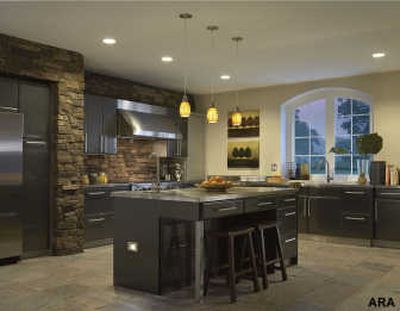Lighting plays key role in conserving energy

There has been a lot of talk lately in households across America about cutting back. The national debt is in the trillions, the sub-prime mortgage mess has left more than a million homes in foreclosure, gas prices are at an all-time high and budgets are tighter than ever.
If you had to choose a buzzword for 2008 it would be conservation. People are looking for ways to conserve money and resources, and one of the easiest, and most obvious places to cut back is on the amount of electricity you use in the home, starting with the lighting.
Here are some ideas to get you started:
1. Replace your old incandescent light bulbs with more energy efficient ones.
The Department of Energy reports that we spend, on average, 5- to 10 percent of our electric bills on lighting in our homes. In some regions of the U.S. this amount can be as high as 25 percent where air conditioning is a modest portion of the bill.
“Incandescent lamps have historically been the most frequently used in residential applications due to their low initial cost. Incandescent sources, however, are relatively inefficient in their conversion of electrical energy to visible light. Inefficiency translates to higher operation costs. Simply replacing incandescents with more energy efficient fluorescent or LED bulbs will make a huge difference,” says Joe Rey-Barreau, an education consultant for the American Lighting Association (ALA) and associate professor at the University of Kentucky.
In recent years, lighting manufacturers have spent a lot of time designing decorative fixtures that utilize these new, more energy-efficient bulbs. “In the past, so called ‘green’ products and lighting fixtures were not known for performing well, but we’ve invested a lot of time in creating fixtures that are both aesthetically pleasing and more energy efficient,” says Colleen Visage, senior product manager for Progress Lighting.
Similar work has been underway at Savoy House Lighting of Braselton, Ga., where they have developed an entire line of outdoor fixtures called Dark Sky that use Energy Star- rated compact florescent bulbs. “It’s extremely important with all the Congressional standards coming out that every manufacturer go in this direction,” says Kelle Hollenback, the company’s national sales manager. “Green is the wave of the future.”
2. Use light controls.
These allow you to save energy by either reducing operating time or light output.
Photocells, which turn lights on and off in response to natural light levels, occupancy sensors which activate when a person walks into the room, vacancy sensors and motion sensors all save energy by reducing the operating time. Dimmers, current limiters, auto daylighting controls and EMCS (Energy Management Control Systems) save energy by reducing the light output and input power.
Of all the energy-saving options, Irene Wang, President of Designers Fountain, Inc., in Rancho Dominguez, Calif., likes dimmer switches the best. “They offer great versatility and add richness to any room,” she says. “They allow you to leave bathroom or hallway lights dimmed for small children or overnight guests, and can also make the living room, family room or a bedroom feel more romantic and cozy.”
3. Use low voltage lighting.
Installing low voltage lights in areas where minimal lighting is needed is another option to consider. “Low voltage is an efficient light source and can be installed with a dimming control,” says Jody De Vine of Sea Gull Lighting Products, Inc. “Low Voltage under cabinet lighting, for instance, delivers the right light to enhance kitchen tasks, yet when dimmed can help set a mood for entertaining.”
For more energy saving tips regarding lighting and to find a lighting showroom near you that offers energy-efficient lighting products, log on to the American Lighting Association’s Web site: www.americanlightingassoc.com or call 800-BRIGHT-IDEAS (800-274-4484).
4. Stop Wasting Energy.
Get into the habit of turning things off when you leave a room. Not just lights, but fans, television sets, radios, etc. Not using what you don’t need will make a big impact on your energy consumption.
5. Find and eliminate “phantom loads,” items that use energy even when they are turned off.
Prime examples include TV sets, DVD players, cell phone chargers and the like. Usually these devices will use a small trickle of energy either to allow them to be switched on for rapid use, or to retain memory. To curb these loads, you can attach them all to inexpensive switched power strips and turn them off for real when they’re not doing useful work for you.
6. As they break down, replace older appliances with high efficient ones that will require less energy to get the same work done.
Look for appliances that have the Energy Star rating, meaning they have met rigorous government requirements regarding energy efficiency.